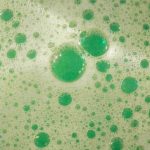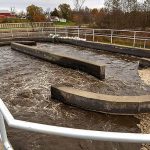pH that is too high or too low will have negative effects on the fish. Low pH can cause damage to the gills, skin and eyes. Higher H+ concentrations will also increase the permeability of the gills, leading to leakage of Na+ and Cl− which creates osmotic problems. First, the effects can be regis-tered as a reduction in growth; too low a pH will kill the fish. In natural populations, the pH may vary from 5 to 9, but for aquaculture facilities it is rec-ommended to be in the range 6.5–9. Problems with metals in the water are best avoided; tolerance may vary with fish species and life stage, with newly hatched fry being especially sensitive. For crayfish, for example, the pH and alkalinity must be high because they utilize Ca2+ in the water for shell synthesis.
The solubility of metal ions in the water will increase with reduction in pH. There have been particular problems with the concentrations of aluminium (Al+ + +) in fish farming; this metal leaches from the soil or bedrock in the catchment area. The toxicity of the complexes of Al or Al precipitates varies. A drop in pH will change the existing Al complexes to more toxic ones, meaning that fatalities can occur even if the pH itself does not represent any danger. The most stable and non-toxic forms of Al are in the pH range 6.5–6.8. Calcium will ameliorate problems with aluminium because it protects the gills from aluminium and also from acidity.6 Toxic effects also depend on temperature, because rate of reaction increases with rise in temperature. Normally is it therefore not the pH that is dangerous, but the combination of low pH and metal ions.
Some of the aluminium or other metal complexes that are toxic are unstable and will only persist for a short period. This may occur when mixing water with different qualities and characteristics, and a mixed zone of water with different qualities is achieved. If this reaches the fish tanks, fatalities may result. It is really important to be aware of this in intensive fish farming, where water from sources of different quality and temperature is mixed just before entering the fish tank. For instance, a brief drop in pH may occur in a water source due to fall of acid rain or ice melting in the catchment area; this may create a mixed zone in the water source (river or lake).7 Where single Al complexes coagu-late and create larger, more toxic Al complexes.
In mixing zones is aluminium entering the gills causes osmotic stress.6When it is taken up, it can cause damage to the nervous system and block enzymatic reactions. As a defence mechanism, mucus may be secreted and oxygen uptake is thereby reduced, which may result in death. If there is a possibility of problems with metals ions, choice of the correct adjustment agent is important.
Water alkalinity for intensive fish farming and pond aquaculture is recommended to be above 40 mg/l CaCO3 to stabilize the pH and protect health and physical quality.3 Alkalinities in the range 100–200 mg/l CaCO3 will, however, give several additional advantages, including making a stable water source for biofilters in a re-use circuit, adding buffer capacity to avoid pH fluctuation in ponds, and reducing the toxicity of heavy metals.8 In ponds there will be a fluctuation in pH during the day and night due to biological processes. During the night the algae (phytoplankton) and fish will release CO2 so the pH will drop if the alkalinity is low; during the daytime the algae will consume CO2 by photo-synthesis faster than the fish release it; therefore the pH will increase. The pH can vary from 5 to 10.


